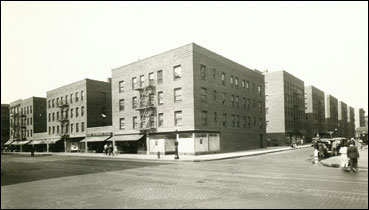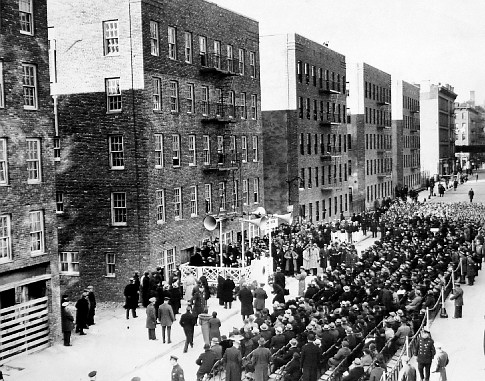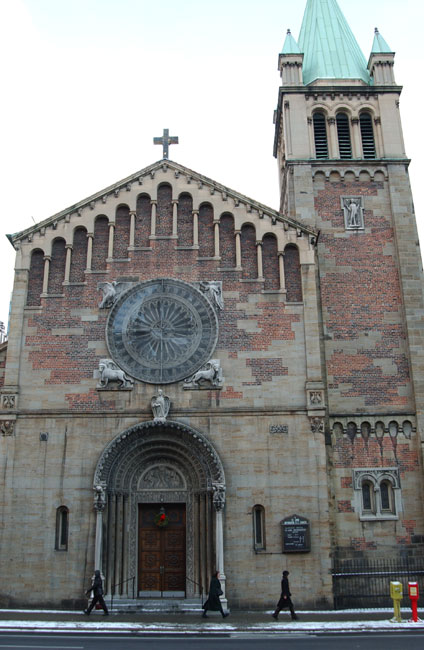Should I apologize for my long absence? Have you all been waiting by the computer for me to write? I know a lot of bloggers out there post multiple things a day. But hey, that means by my analysis that I’m only about 264 posts behind since last time. Piece of cake! Let me just take a nap first and I’ll get right on it.
There’s still so much I want to talk about! Remember how we were starting to look at some limited equity co-ops on the Lower East Side – as a kind of warm up to looking at some of the public housing? Well let’s look at some of the public housing! I’ve been thinking about it.
Because you read Jane Jacobs’ The Death and Life of Great American Cities (for example) and you come away feeling like public housing in the United States has been a failure. Which it largely has been, both in execution and in design. I mean in its physical design, which is what Jane especially goes after: the whole tower in the park thing; separating the development from the activity of the street and so ensuring that it will be unvisited by everyone who doesn’t live there and hence (in practice) be unwelcoming and unsafe for almost everyone (eg. you don’t walk through the projects, you walk around them). In the larger sense of its design, as in the way it was envisioned, you could argue that public housing is a failure as well – made intentionally shoddy so as not to compete with private real estate concerns. It had to be in essence for the poorest of the poor, because if it was for the working class, or (god forbid) the middle class even, they might start thinking that they didn’t have to get a mortgage (fully insured by the federal government – don’t call that government spending though) and buy their house on the private market. And once it was for the poorest of the poor that pretty much sealed the deal in terms of execution – namely that the execution would be poor. Poor for the poorest of the poor. Spend very little money on the upkeep and security, etc, and then talk about what animals these poorest of the poor are to let their living spaces go this way.
This notion of public housing being a failure goes much further than Jane Jacobs of course (who after all, published her book in 1961) – at this point it’s part of pop culture really: the projects equal bad. But there’s a kind of a false conflation that goes on I think in this notion of the failure of public housing – namely, equating the failure in design and execution with a failure in intentions or goals. The point of public housing is to provide affordable housing. And public housing does this by providing large apartment buildings that are 100% affordable (as opposed to inclusionary zoning’s 20%, for example). Now yes, these are 100% affordable apartment buildings that in many cases need a lot of improvement in terms of maintenance and security but these are 100% affordable apartment buildings that a lot of people want to live in (in NYC the waiting list is close to 250,000 families). So yes, again, it needs some help in the execution, but the fundamental idea is sound. People need affordable housing. The private market often does a bad job in providing it. If the government wants affordable housing it should build affordable housing. That’s what it used to do!
And it did it first in NYC of course. New York is home to the first public housing built in the United States – appropriately named First Houses – opened to its first tenants on Dec. 3 1935, as the first project of the newly created New York City Housing Authority (NYCHA). The 4-5 story, 8 building development still stands on 3rd St. between First Avenue and Avenue A, with a portion running down Avenue A to 2nd St. (and yeah, I know they might not be much to look at, but hey, it’s public housing). The project replaced a number of older tenements on the site as an act of “slum clearance” – one of the requirements of the federal funding it received. The original idea had been to only replace every third tenement with new buildings but it was soon apparent that they were all in such poor structural condition that the whole lot would have to go. Not all the owners were happy about this, and when one contested (Andrew Muller) – on the grounds that seizing the buildings, even with “just compensation,” went against the New York State (not to mention the United States) Constitution – the case made it all the way to the New York State Court of Appeals. The court ultimately sided with the city, in what would serve as a landmark case regarding eminent domain.
But not all of the owners were so opposed. In fact the principal owner of the site was one Vincent Astor, son of John Jacob Astor IV, himself the son of William Backhouse Astor Jr. and Caroline Webster Schermerhorn Astor (man, even when you’re talking about low income housing it’s hard to stay away from these folks). Vincent Astor had inherited the site – along with a massive fortune – at the age of 20, after his father died on the Titanic. By the early 1930s he had dedicated himself to philanthropy and was looking to separate himself from the role of slumlord. He sold his parcels to NYCHA for half of their assessed value – a purchase made possible in large part by the issuance of a tax-free 66-year bond by NYCHA that effectively established the Authority’s credit.
It was a big deal when First Houses opened – serving 122 families at an average monthly rent of $6.05 per room (equivalent to roughly $100 per room today). The dedication in Dec. of 1935 was broadcast on national radio and besides the reading of a congratulatory telegram from President Roosevelt, included speeches by Mrs. Roosevelt, Mayor LaGuardia, Governor Lehman, Robert Moses (of course! he was everywhere) and a whole host of other names I want to explore someday. There’s a lot more here I want to explore! Can you all wait for it? (By my analysis there are approximately 4 of you). Take a nap and get back to me.





